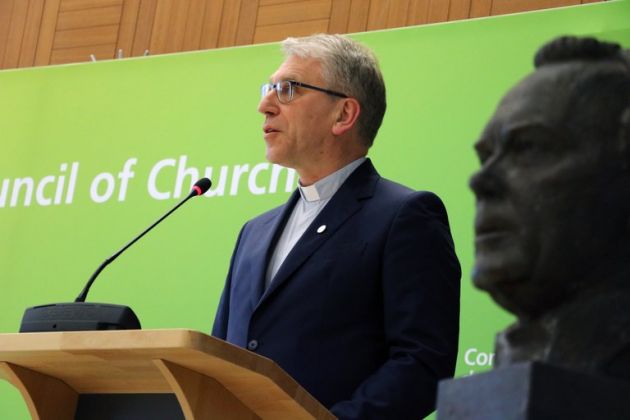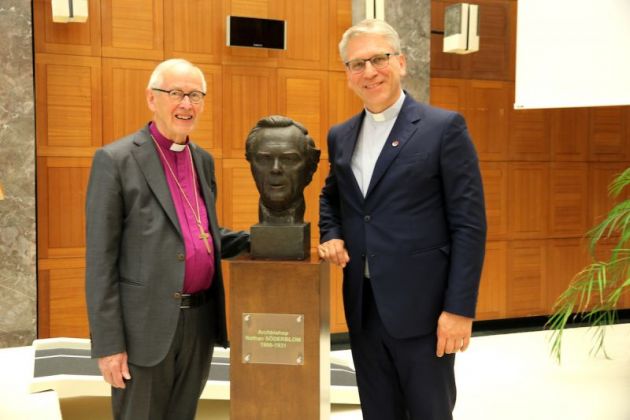The man who 'envisioned a new way of being church' when the world was in crisis

The First World War had started, and the planet was in crisis when he became Archbishop of Uppsala in 1914, but through it all, ecumenical trailblazer and peace-seeker Nathan Söderblom envisioned a new way for the Church, a man who acted.
Prof. Simone Sinn, professor of Ecumenical Theology at the World Council of Churches Ecumenical Institute in Bossey observed on June 3, the world was then "being scattered" as it is now and there was "fear, hatred and hostility" in the world, as there is now.
Söderblom, however, "engaged with crisis by envisioning new relations in the light of the Gospel," she said, speaking at a Nathan Söderblom seminar.
"He opened the way for the church to envision a new way of being church in the world," said Sinn at the half-day seminar at the WCC, co-sponsored by the Church of Sweden.
'ECUMENICAL MOVEMENT HAS MATURED'
She said, "Ecumenical relations are a part of being church today, and that was not the case 100 years ago. The ecumenical movement has matured."
At the seminar, his biographer, Swedish ecumenical scholar Bishop Emeritus Jonas Jonson spoke about his book "Nathan Söderblom - called to serve."
He sketched the outgoing aesthetic, who inspired, a linguist, visionary and motivator who travelled to the United States as a young man in a spirit of ecumenism that brought in those from the Orthodox tradition, Roman Catholicism and other faiths.
The WCC seminar was truly ecumenical as in the audience were students from the Ecumenical Institute, and the Institute for Orthodox Theology Higher Studies at Chambésy with many followers online. A representative of the Vatican was also present.
The students engaged with ecumenical doyens in discussing the spirituality and deeds of an ecumenical visionary whose encounters with those of other faiths might have seemed ahead of his time but whose health let him down at the age of 65 in 1931.
Jonson recounted the life of Söderblom in a spell-binding story, sketching his earlier life that inspired students and academia with his far-reaching vision of the church and the world.
"He had shared the pre-war lightness of heart, the taste of modernity and the confidence that religion, culture, science and technology would bring a bright future to humanity.
"With commitment and inexhaustible energy, he had personified pre-war optimism and progress, enjoyed open borders, scholarly exchange, and the early signs of Christian cooperation and unity."
STATUE TO INSPIRE GENERAL SECRETARIES
Such is his ecumenical influence that WCC general secretary Rev. Dr Olav Fykse Tveit reflected on his statue outside his office at the Ecumenical Centre and how he effused an ecumenism of love:
"Since my first day as the general secretary of the World Council of Churches, I have looked into the face of Lars Olof Jonathan Söderblom, called Nathan, a Swedish clergyman who was the Church of Sweden Archbishop of Uppsala between 1914 and 1931. In 1930 he was awarded the Nobel Peace Prize for his work to unite the churches for peace."
Tveit noted, "He was able to bring people together in relations that really matter...He was not afraid of being a critical voice."
Jonson observed that when Söderblom became archbishop, "No bishop and few among the clergy gave him their vote. Still, the government proposed him, and the king confirmed the appointment.
"Choosing him would possibly ease off a prevailing political polarization and at the same time help in renewing the aging church, as Söderblom was known not only for his modern theology but also for sympathies with the labour movement as well as royalism and support of the armed forces."
His fellow bishops "found him unpredictable, too un-dogmatic, and often too radical on social matters, and they looked upon his ecumenical and international projects for unity and peace as his own personal enterprise."
Still, he soon established himself, "as the most charismatic, open-minded and energetic archbishop the Church of Sweden had seen since the sixteenth-century reformation."
Despite Soderblorn's popularity, he faced peer disapproval until the end of his life. His "extraordinary relief work during and after the war," and his membership of the Swedish Academy, and his recognition as one of the most respected personalities in Europe silenced his critics.
"Only after the Universal Christian Conference on Life and Work in Stockholm in 1925, and even more so after the Nobel Prize in 1930 and his unexpected death in 1931, did objections give way to unanimous national and international praise. He then became an icon of goodwill and saintliness," said Jonson.
NOBEL PEACE PRIZE
The man who would gain the Nobel Peace Prize shortly before his death "was not a systematic theologian with a well-developed Christology or ecclesiology. Christian ethics and practical action took precedence over church dogmatics; the universal spirit of God was of greater significance than incarnational sacramentality; the cross of reconciliation was more faith-inspiring than the resurrection," said Jonson.
Dr. Georges Tsetsis, who was from 1985 to 1999 the permanent representative of the Ecumenical Patriarchate, is the author of a paper titled "Nathan Söderblom and the Orthodox Church."
Tstetis has written, "One of the most interesting aspects of contemporary church history has been the relationship established around 1918 between Archbishop Nathan Söderblom of Uppsala and the Ecumenical Patriarchate of Constantinople - a relationship which, no doubt, constituted a key element in the evolution of the present-day ecumenical movement."

